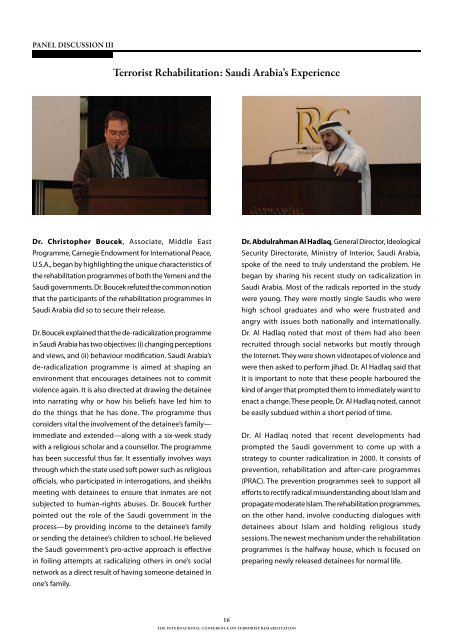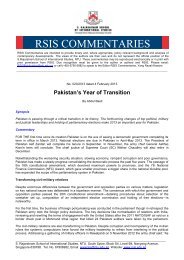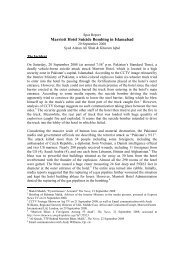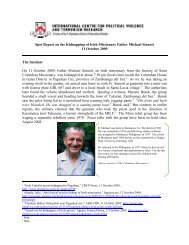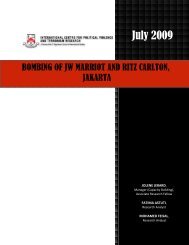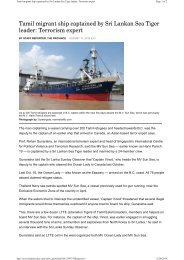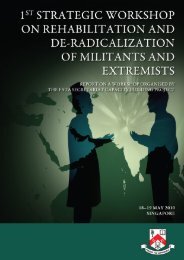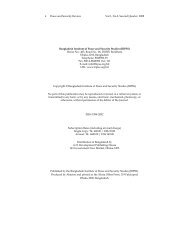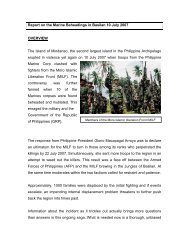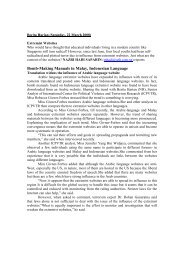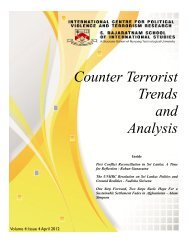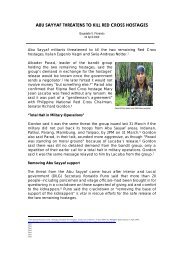International Conference On Terrorist Rehabilitation
International Conference On Terrorist Rehabilitation
International Conference On Terrorist Rehabilitation
You also want an ePaper? Increase the reach of your titles
YUMPU automatically turns print PDFs into web optimized ePapers that Google loves.
PANEL DISCUSSION III<br />
<strong>Terrorist</strong> <strong>Rehabilitation</strong>: Saudi Arabia’s Experience<br />
Dr. Christopher Boucek, Associate, Middle East<br />
Programme, Carnegie Endowment for <strong>International</strong> Peace,<br />
U.S.A., began by highlighting the unique characteristics of<br />
the rehabilitation programmes of both the Yemeni and the<br />
Saudi governments. Dr. Boucek refuted the common notion<br />
that the participants of the rehabilitation programmes in<br />
Saudi Arabia did so to secure their release.<br />
Dr. Boucek explained that the de-radicalization programme<br />
in Saudi Arabia has two objectives: (i) changing perceptions<br />
and views, and (ii) behaviour modification. Saudi Arabia’s<br />
de-radicalization programme is aimed at shaping an<br />
environment that encourages detainees not to commit<br />
violence again. It is also directed at drawing the detainee<br />
into narrating why or how his beliefs have led him to<br />
do the things that he has done. The programme thus<br />
considers vital the involvement of the detainee’s family—<br />
immediate and extended—along with a six-week study<br />
with a religious scholar and a counsellor. The programme<br />
has been successful thus far. It essentially involves ways<br />
through which the state used soft power such as religious<br />
officials, who participated in interrogations, and sheikhs<br />
meeting with detainees to ensure that inmates are not<br />
subjected to human-rights abuses. Dr. Boucek further<br />
pointed out the role of the Saudi government in the<br />
process—by providing income to the detainee’s family<br />
or sending the detainee’s children to school. He believed<br />
the Saudi government’s pro-active approach is effective<br />
in foiling attempts at radicalizing others in one’s social<br />
network as a direct result of having someone detained in<br />
one’s family.<br />
Dr. Abdulrahman Al Hadlaq, General Director, Ideological<br />
Security Directorate, Ministry of Interior, Saudi Arabia,<br />
spoke of the need to truly understand the problem. He<br />
began by sharing his recent study on radicalization in<br />
Saudi Arabia. Most of the radicals reported in the study<br />
were young. They were mostly single Saudis who were<br />
high school graduates and who were frustrated and<br />
angry with issues both nationally and internationally.<br />
Dr. Al Hadlaq noted that most of them had also been<br />
recruited through social networks but mostly through<br />
the Internet. They were shown videotapes of violence and<br />
were then asked to perform jihad. Dr. Al Hadlaq said that<br />
it is important to note that these people harboured the<br />
kind of anger that prompted them to immediately want to<br />
enact a change. These people, Dr. Al Hadlaq noted, cannot<br />
be easily subdued within a short period of time.<br />
Dr. Al Hadlaq noted that recent developments had<br />
prompted the Saudi government to come up with a<br />
strategy to counter radicalization in 2000. It consists of<br />
prevention, rehabilitation and after-care programmes<br />
(PRAC). The prevention programmes seek to support all<br />
efforts to rectify radical misunderstanding about Islam and<br />
propagate moderate Islam. The rehabilitation programmes,<br />
on the other hand, involve conducting dialogues with<br />
detainees about Islam and holding religious study<br />
sessions. The newest mechanism under the rehabilitation<br />
programmes is the halfway house, which is focused on<br />
preparing newly released detainees for normal life.<br />
16<br />
THE INTERNATIONAL CONFERENCE ON TERRORIST REHABILITATION


